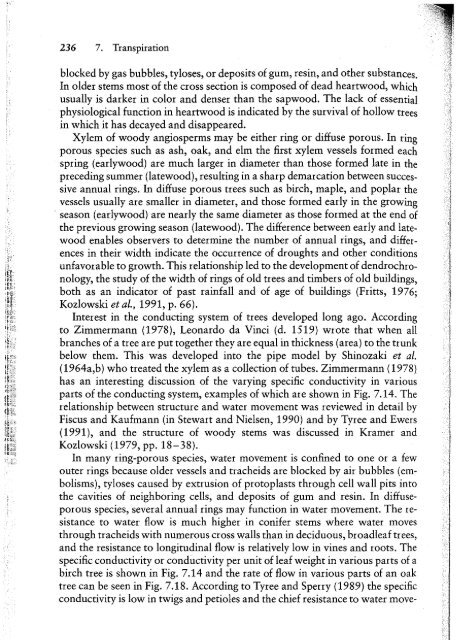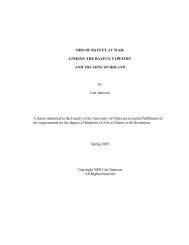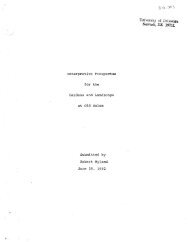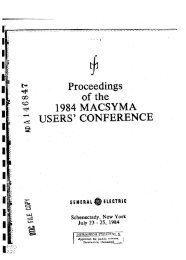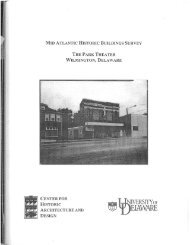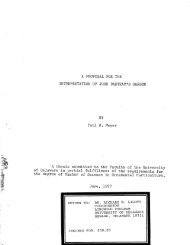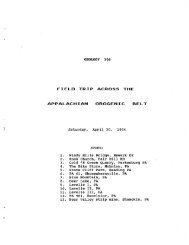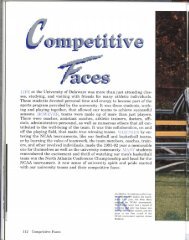Transpiration and the Ascent
Transpiration and the Ascent
Transpiration and the Ascent
Create successful ePaper yourself
Turn your PDF publications into a flip-book with our unique Google optimized e-Paper software.
236 7. <strong>Transpiration</strong><br />
blocked by gas bubbles, tyloses, or deposits of gum, resin, <strong>and</strong> o<strong>the</strong>r substances.<br />
In older stems most of <strong>the</strong> cross section is composed of dead heartwood, which<br />
usually is darker in color <strong>and</strong> denser than <strong>the</strong> sapwood. The lack of essential<br />
physiological function in heartwood is indicated by <strong>the</strong> survival of hollow trees<br />
in which it has decayed <strong>and</strong> disappeared.<br />
Xylem of woody angiosperms may be ei<strong>the</strong>r ring or diffuse porous. In ring<br />
porous species such as ash, oak, <strong>and</strong> elm <strong>the</strong> first xylem vessels formed each<br />
spring (earlywood) are much larger in diameter than those formed late in <strong>the</strong><br />
preceding summer (latewood), resulting in a sharp demarcation between Successive<br />
annual rings. In diffuse porous trees such as birch, maple, <strong>and</strong> poplar <strong>the</strong><br />
vessels usually are smaller in diameter, <strong>and</strong> those formed early in <strong>the</strong> growing<br />
season (earlywood) are nearly <strong>the</strong> same diameter as those formed at <strong>the</strong> end of<br />
<strong>the</strong> previous growing season (latewood). The difference between early <strong>and</strong> latewood<br />
enables observers to determine <strong>the</strong> number of annual rings, <strong>and</strong> differences<br />
in <strong>the</strong>ir width indicate <strong>the</strong> occurrence of droughts <strong>and</strong> o<strong>the</strong>r conditions<br />
unfavorable to growth. This relationship led to <strong>the</strong> development of dendrochronology,<br />
<strong>the</strong> study of <strong>the</strong> width of rings of old trees <strong>and</strong> timbers of old buildings,<br />
both as an indicator of past rainfall <strong>and</strong> of age of buildings (Fritts, 1976;<br />
Kozlowski et at., 1991, p. 66).<br />
Interest in <strong>the</strong> conducting system of trees developed long ago. According<br />
to Zimmermann (1978), Leonardo da Vinci (d. 1519) wrote that when all<br />
branches of a tree are put toge<strong>the</strong>r <strong>the</strong>y are equal in thickness (area) to <strong>the</strong> trunk<br />
below <strong>the</strong>m. This was developed into <strong>the</strong> pipe model by Shinozaki et al.<br />
(1964a,b) who treated <strong>the</strong> xylem as a collection of tubes. Zimmermann (1978)<br />
has an interesting discussion of <strong>the</strong> varying specific conductivity in various<br />
parts of <strong>the</strong> conducting system, examples of which are shown in Fig. 7.14 ..The<br />
relationship between structure <strong>and</strong> water movement was reviewed in detail by<br />
Fiscus <strong>and</strong> Kaufmann (in Stewart <strong>and</strong> Nielsen, 1990) <strong>and</strong> by Tyree <strong>and</strong> Ewers<br />
(1991), <strong>and</strong> <strong>the</strong> structure of woody stems was discussed in Kramer <strong>and</strong><br />
Kozlowski (1979, pp. 18-38).<br />
In many ring-porous species, water movement is confined to one or a few<br />
outer rings because older vessels <strong>and</strong> tracheids are blocked by air bubbles (embolisms),<br />
tyloses caused by extrusion of protoplasts through cell wall pits into<br />
<strong>the</strong> cavities of neighboring cells, <strong>and</strong> deposits of gum <strong>and</strong> resin. In diffuseporous<br />
species, several annual rings may function in water movement. The resistance<br />
to water flow is much higher in conifer stems where water moves<br />
through tracheids with numerous cross walls than in deciduous, broadleaf trees,<br />
<strong>and</strong> <strong>the</strong> resistance to longitudinal flow is relatively low in vines <strong>and</strong> roots. The<br />
specific conductivity or conductivity per unit of leaf weight in various parts of a<br />
birch tree is shown in Fig. 7.14 <strong>and</strong> <strong>the</strong> rate of flow in various parts of an oak<br />
tree can be seen in Fig. 7.18. According to Tyree <strong>and</strong> Sperry (1989) <strong>the</strong> specific<br />
conductivity is low in twigs <strong>and</strong> petioles <strong>and</strong> <strong>the</strong> chief resistance to water move-


